Multi AI chat clients are your saviour if you’re dying from subscription fatigue or simply tired of managing and switching among many AI models you might have. Besides, the need for a consistent user interface and advanced teamwork features asks for more than what LLM providers can deliver individually.
In this article, I’ll mainly cover platforms that allow managing multiple AI models from a single interface. The entries primarily consist of BYOK setups, cloud subscriptions, and local deployments.
Here’s the list.
- 1. TypingMind
- 2. Geekflare AI
- 3. Chatbox AI
- 4. Magai
- 5. TeamAI
- 6. OpenRouter
- 7. Poe
- 8. Anything LLM
- Show less
I will now discuss these multi-AI chat platforms in detail with their UI, pros and cons and pricing plans.
1. TypingMind
TypingMind provides access to LLMs from OpenAI, Anthropic, and OpenAI by default, and you can also set custom models for yourself.
The UI has tons of features right there, which can make it overwhelming for beginners. While some may appreciate the feature overload with this representation, personally, I’m more of a clean and minimalist look person.

Moving over my mini rant, the leftmost panel hides the most configurations underneath. First, you have the Agents to browse/build specialty chatbots. Some of them are right there on the chat dashboard, including Cold Email Templates and Pro Coder.
Building an entirely new chatbot is also super easy. You simply select the model (and parameters), plugins (web search, Dall-E , etc.), turn on text-to-speech (ElevenLabs, OpenAI, and browser), plug training files, and more. Overall, it’s noob-friendly, but experts have the space to flaunt their expertise as well.
Plugins are the capabilities you turn on/off while chatting. As of this writing, there were exactly 25 of them, covering web search, image search, PowerPoint, Word, and Excel generation, JavaScript interpretation, Azure AI search, and more. Adding them to your chat interface or your custom AI agent doesn’t cost anything extra.
You will be surprised to see an extensive list of AI models from OpenAI, Google, and Anthropic. I could see greater model access when compared to my premium ChatGPT subscription. For instance, TypingMind still has GPT-4 which I can no longer use within ChatGPT. Additionally, you can add a custom model from other providers, too.
One advanced feature is connecting knowledge bases (different from training files) from multiple cloud platforms, such as Confluence, Google Drive, OneDrive, Notion, Salesforce, HubSpot, Dropbox, etc. This will enable the bot to answer some specific questions more accurately.
TypingMind has recently introduced its Teams version. This provides admins with data about token spend, total messages, top used AI agents in a time frame, regulate access, analytics, etc. Teams plan also comes with additional features, such as 50 pre-built AI specialty agents, API connectivity for real-time data, prompt chaining calling multiple agents, SSO, and security compliance (ex., GDPR, SOC 2 Type II, and HIPAA).
Pros
Links to cloud-based knowledge bases
Bring your own key (BYOK) support
Read-to-use custom agents
Lifetime license available
Cons
Feature overload can repel users eyeing plain simple multi-modal AI chat
Lacks clarity regarding update cycle of the base tiers (except the top one)
TypingMind Pricing
You can try TypingMind with an API key for free. However, premium abilities, including text-to-speech, image generation, voice inputs, and more, are pay-walled.
- Standard: $39
- Extended: $79
- Premium: $99
2. Geekflare AI
Geekflare AI is our own contribution to the multi-modal AI access space. We have prioritized the interface for business professionals looking for clean aesthetics without outright feature clutter.
The central area is mostly dedicated to the prompting and some suggestions for getting started quickly. You can check the chat history in the left panel and put sensitive conversations in a separate folder under the private category.
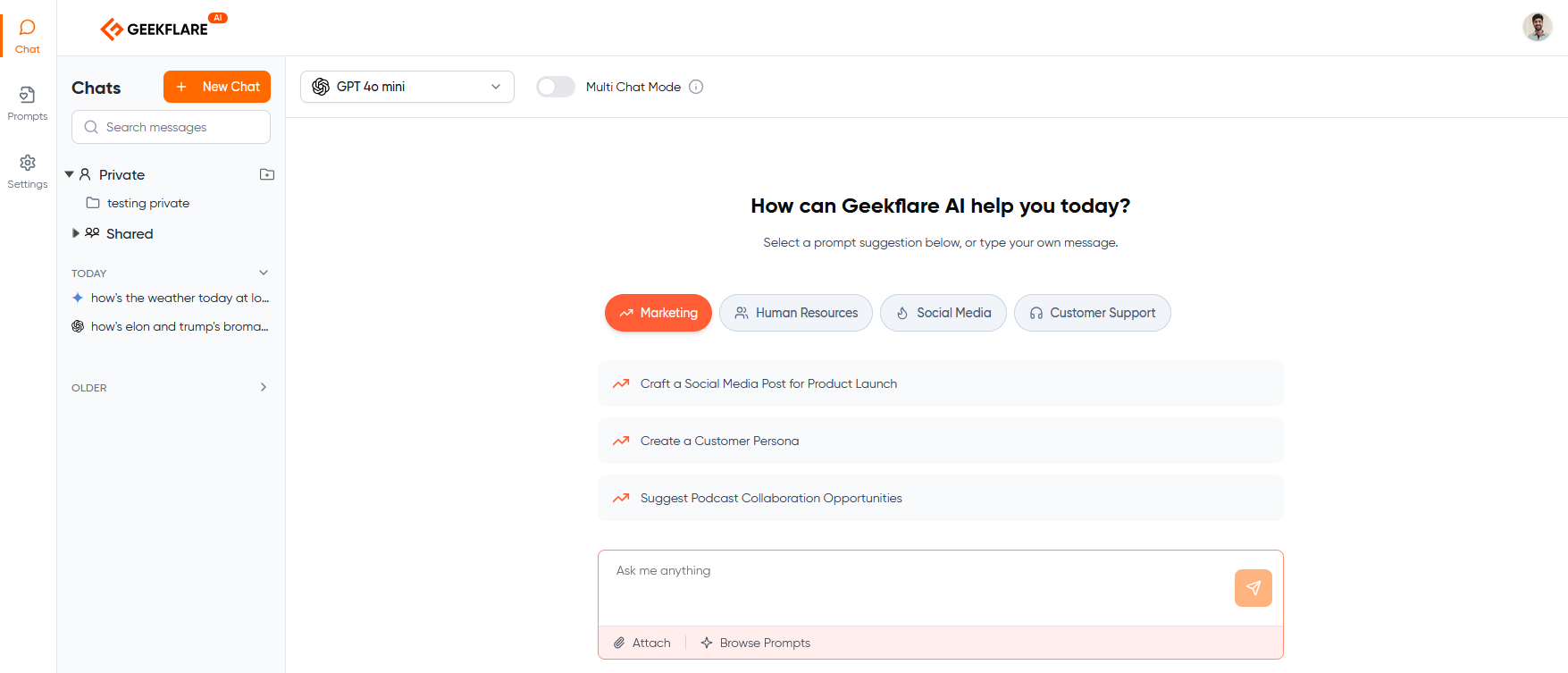
One of the best parts of Geekflare AI is a multi-modal mode, which allows chatting with up to three AI models simultaneously.
Moreover, Geekflare AI is best for anyone breaking into prompting as it comes with an in-built prompt library covering various business domains, such as marketing, sales, customer support, project management, and more. You can also create and save custom prompts for use at a later stage.
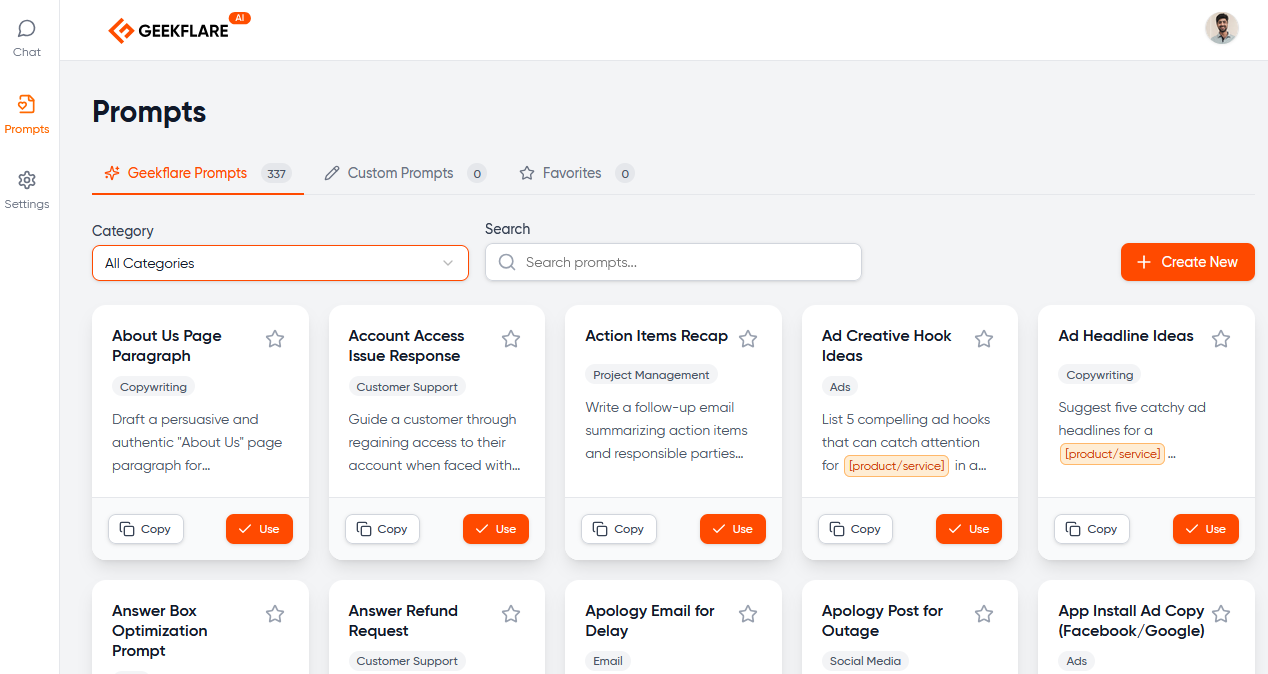
As of now, you have LLMs from leading providers, including OpenAI, Anthropic, and Google, to play with under the BYOK model. You can also attach documents for chatting with their contents.
We are planning to include web search, chat sharing, and the ability to create images in the coming updates.
Pros
Chat with multiple AI models at once
Native prompt library
Excellent interface with plenty of white space
Cons
AI web search and image creations are yet to materialize
Still in beta
Geekflare AI Pricing
You can use Geekflare AI for free as long as it’s in beta mode.
3. Chatbox AI
Chatbox AI puts multiple AI models under one simple subscription, priced at just $3.5/month, making it perfect for AI generalists. However, you still have the more popular, BYOK (bring your own key), if you’re a pro user. Supported AI providers include OpenAI, Claude, Gemini, Deepseek, xAI, Perplexity, and Grok, and model aggregators such as Ollama and LM Studio.
The offering is coupled with “standard” AI features, such as document chat, real-time web search, and image creation. But the best part about Chatbox AI is that it’s not limited to a web interface but also has native apps for Windows, macOS, Linux, iOS, and Android.
The interface is clear, featuring ready-made copilots (explained later), and Settings on the left panel. The Settings are is where one can browse through the LLM support and activate them with specific keys.
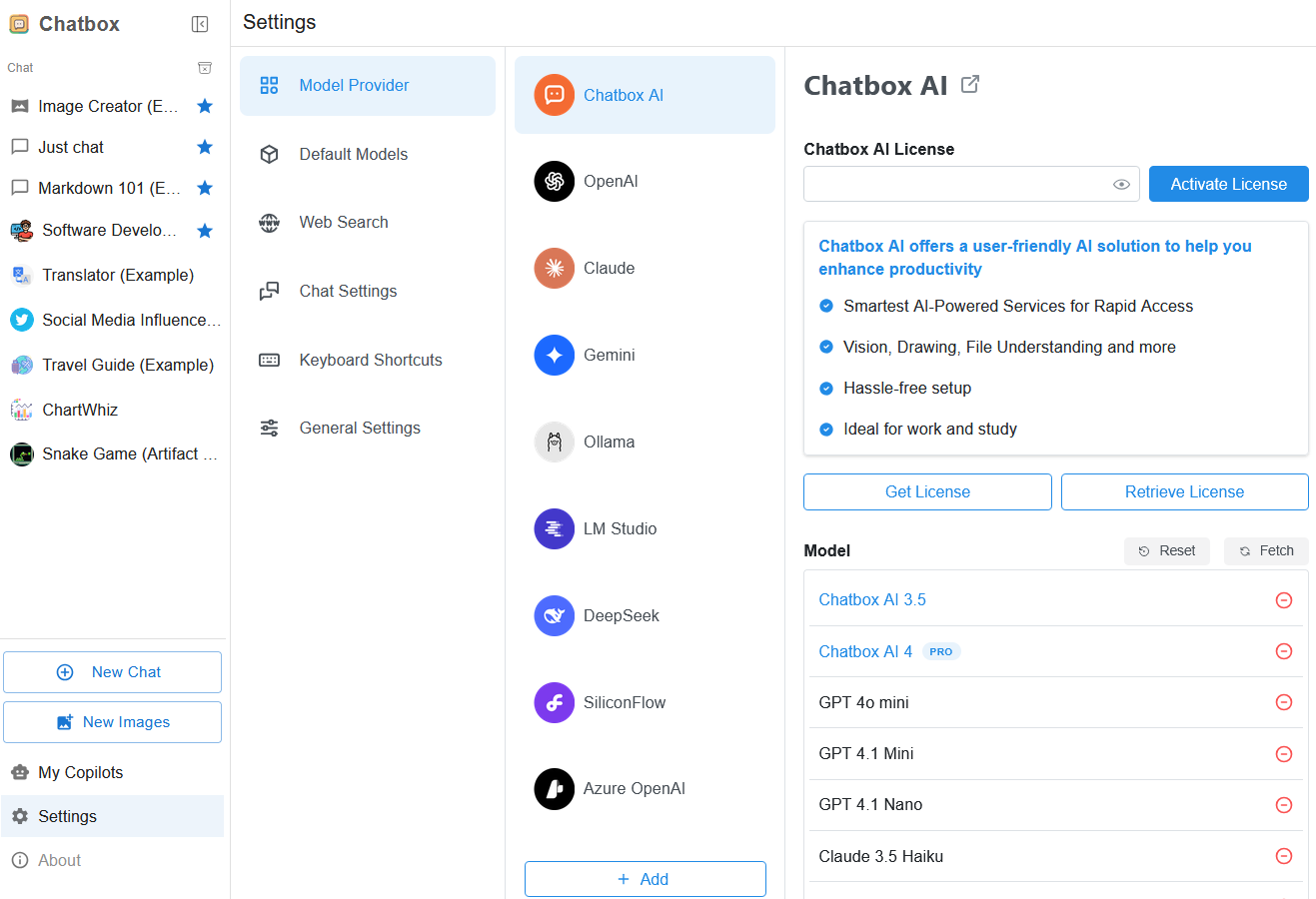
The specialty agents on the left panel are Copilots. You can find all of them in the “My Copilots” tab. One can also add their custom copilots by laying out simple instructions that help the AI bots to output within the user-set guardrails. In addition, users can also set context and control agent creativity.
A few more settings involve setting the default model and web search engine, toggling Markdown and LaTeX, assigning keyboard shortcuts, configuring data backup, and setting up a network proxy.
Pros
Best of both: multiple AI models under one plan and BYOK
Excellent LLM coverage
Chat customization add to the flexibility
Cons
Lacks collaboration features
Copilots without a custom training database will be limited in scope
Chatbox AI Pricing
Besides BYOK, Chatbox AI has the listed subscriptions based on the choice of models, number of chats, and AI drawings, and more.
- Chatbox AI Lite: $3.5/month
- Chatbox AI Pro: $16.7/month
- Chatbox AI Pro+: $33.3/month
4. Magai
Magai includes popular chat and image AI models in one interface, such as GPT, Claude, Perplexity, DeepSeek, Gemini, Grok, Llama, Mistral, Nova, Dall-E, Flux, Imagen, Leonardo, Stable Diffusion, and more. Overall, the model count is almost 50 when you take every entity from all providers into account. And since choose among these models can be tricky for beginners, you also have a “Auto” mode to help picking the right AI based on the query input.
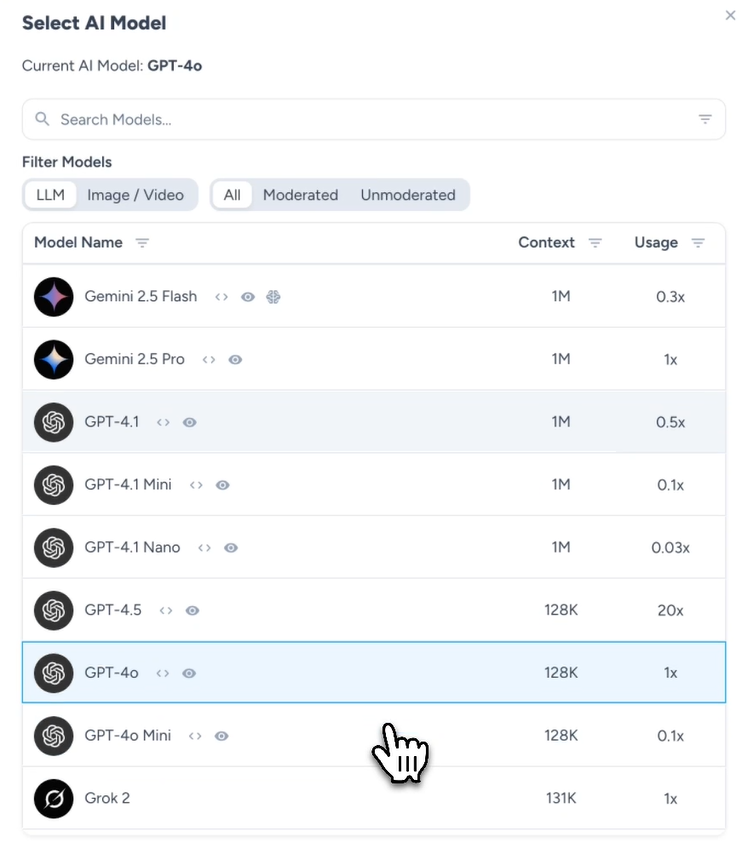
Besides an extensive model support, Magai’s USP is a native document editor with decent text editing features to help you prepare content drafts without switching tabs.
Another noteworthy feature is Prompt Enhance. This is an assistive feature for beginners to identify missing details in their input for a higher-quality output. One also gets a native prompt library for an efficient head start. Magai also lets you modify your input and AI output mid-chat without waiting for the AI to complete.
Magai is built for productivity-intensive team collaboration chores. You can create various workspaces with their specific chats, prompts, personas, and images. And switching among workspaces is possible directly via the chat user interface. This helps agency owners wear different project hats without mixing things up.
Admins can invite members to their workspaces with view, add/edit, and delete permissions. Moreover, content access can be set for individual members.
Pros
Import chat data from ChatGPT and Claude
One of the best LLM availability
Good to have team collaboration suite
Cons
Does not support BYOK
Plan usage limits not clearly mentioned upfront
Magai Pricing
Magai has kept it straightforward with its subscriptions. All models and features are available to both tiers, and the only differentiator is the number of users.
- Solo: $20/month
- Team: $40/month (for five users. Additional seats available)
5. TeamAI
TeamAI is another multi-LLM platform making it to this list. I have included TeamAI primarily for the fact that it provides you access to top models from OpenAI, Gemini, Deepseek, Meta, and Anthropic for a tiny $5/month subscription.
Its collaborative workspace is best for teamwork. TeamAI workspaces feature shared folders, project management, commenting, and more in a unified space.
Business owners also benefit from Team AI’s Agent Designer. It’s a no-code visual builder to make custom AI agents. You can train them on company data, assign specific abilities (ex., web search & image creation), link 3rd-party resources, and more to assist in specific workflows.
TeamAI Workflows is another feature that sets it apart from its competition. This comes with a visual editor to connect a sequence of steps, which can include chatting, web searching, data scraping, or using any custom plugin. It’s advanced yet simple to set up, with plenty of configurations for building the next level of AI agents.
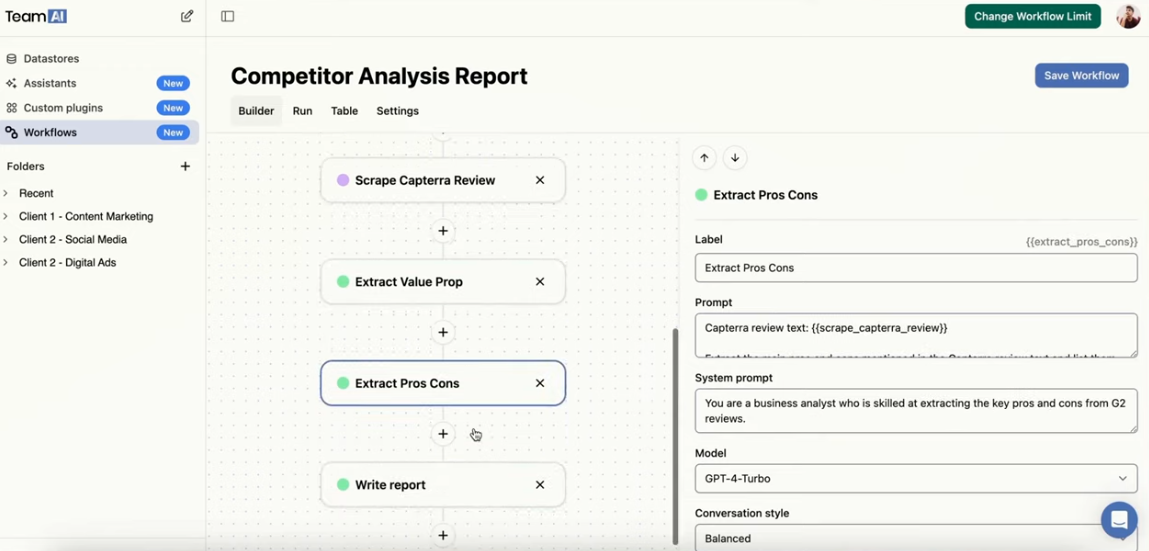
Integrations are yet another upside of TeamAI. You can connect TeamAI to any 3rd-party platform using POST or GET requests. This may include external data repositories or an integration powerhouse such as Zapier.
Pros
AI workflow automation and custom agents are a sure-shot productivity booster
Workspace with granular access are great for team collaboration
Chatbot embeds for building front-end AI
Cons
Entry level paid plan is fairly limited (500 messages a month)
Lacks BYOK possibilities
TeamAI Pricing
Plans start at $5/month without any trial or free tier.
- Individual: $5/month
- Starter: $25/month
- Professional: $149/month
- Enterprise Solutions: $849/month
6. OpenRouter
OpenRouter is a developer-centric tool providing a unified API to access tons of AI models via a single endpoint. One of the OpenRouter highlights is automatic AI mode switching for maximum uptime, while also taking the costs into consideration.

OpenRouter is privacy-friendly. You can configure it to save prompts and responses, or avoid prompt logging altogether. However, it anonymously samples a few prompts for model ranking and user reporting.
Model routing is at the heart of OpenRouter. This runs in two modes: auto-routing (via NotDiamond) and with the models parameter.
Auto mode automatically selects the most effective model for your prompt based on factors such as accuracy, speed, and cost.
On the other hand, the model parameter switches to the next availability in the event the current model fails to reply for reasons such as rate exhaustion or content moderation. This turns to the fallback model next and returns the error if the replacement doesn’t work either.
Other OpenRouter features include prompt caching (to save inference costs), JSON outputs, image and PDF support, uptime optimization (by monitoring AI providers), web search, and zero completion insurance (against failed or no responses).
Developers can deploy OpenRouter with OpenAI SDK, OpenRouter API, or 3rd-party frameworks, such as LangChain, PydanticAI, and Vercel AI SDK.
Pros
Intelligent model routing
400+ AI models support
LLM rankings to check the best AI model based on anonymous user reporting
Cons
Lacks a graphical user interface
Specific features ultimately depend on the AI providers
OpenRouter Pricing
You pay OpenRouter a 5% cut on purchased credits + $0.35 fee for every transaction. The good thing is there is no markup on the cost of AI providers.
7. Poe
I would nominate Poe as the most interesting AI aggregator on this list. It allows access to the latest AI models from the leading providers, enabling text, image, audio, and video generation in a single interface.

Poe also features a Creation Monetization program. Here, you can create custom AI bots, share with others, and set a price per message or sell via a subscription model. Based on the bot type (image, video, text, etc.), you can provide instructions, add a custom knowledge base, use drag and drop or code, and turn on monetization. Creators can configure when to paywall users. One can earn up to $1,250 per subscription and $10k per thousand messages.
Poe clearly feels more inclined towards individual creators or influencers. So, although the UI is pretty functional, you don’t get any teamwork features, such as shared workspaces.
You can use Poe in a web browser or via its apps for Windows, iOS, and Android.
Pros
AI models across multiple creative domains
Bot monetization
Free trial for select bots
Cons
Limited business use because of a lack of collaborative features
No BYOK
Poe Pricing
Unlike most of its competitors, you can also use Poe for free. Paid plans open premium bots, maximum input size, and chat history, starting at $4.17/month.
8. Anything LLM
Anything LLM calls itself “The all-in-one AI application,” which can run locally or on a cloud (self-hosted or subscription), according to user preference. The major selling point of this platform is a simplified setup and private deployment of anything LLM and AI agents.
The desktop version is available for macOS, Windows, and Linux. It offers a one-click installer and completely operates on a single local device. This is best for individuals who don’t require multi-user workflows.
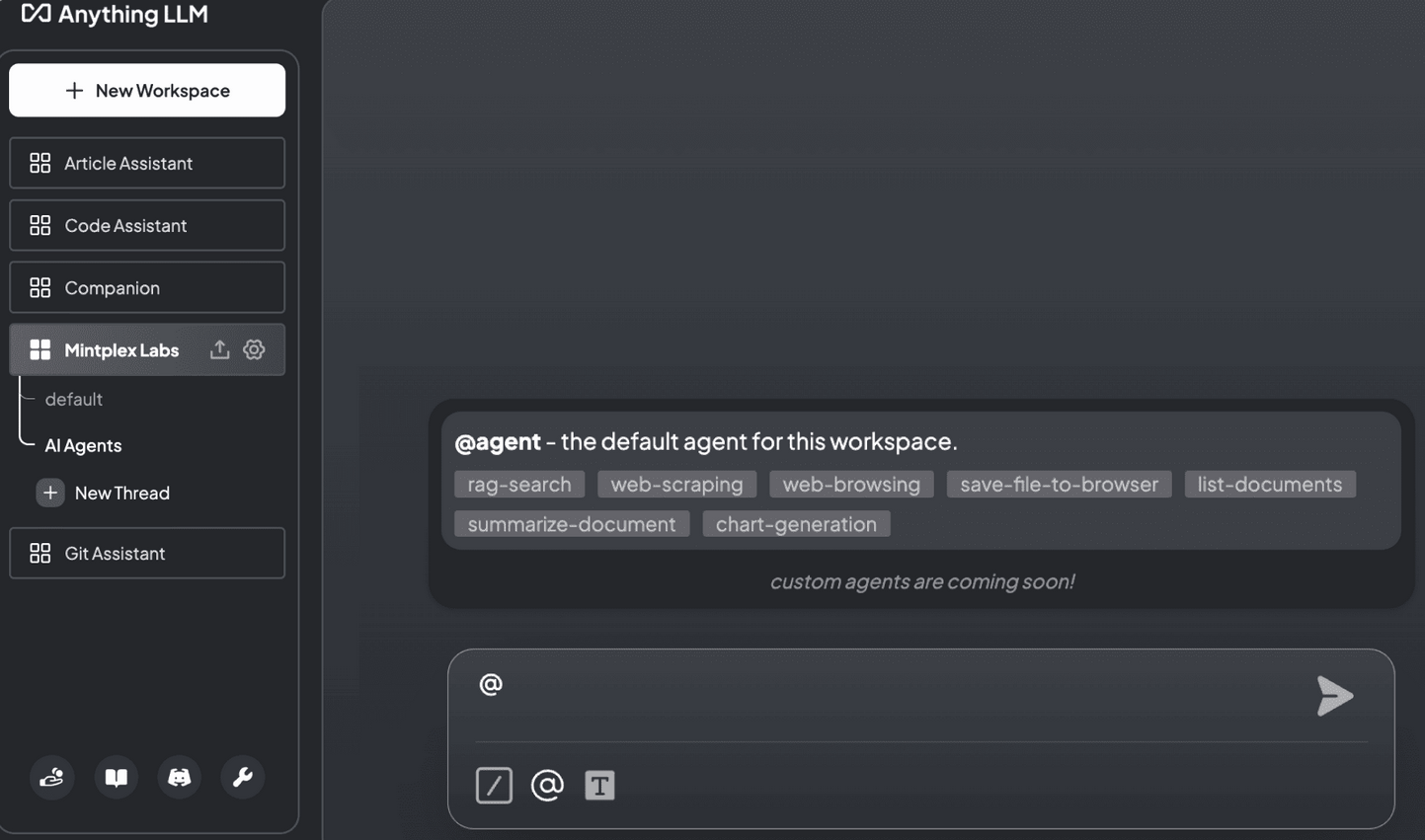
Cloud version (available via Docker) is for teamwork and allows launching a public-facing bot instance. Besides, you get a few more perks, including white labeling, user management, password protection, and workspaces.
However, there are some commonalities across the deployment modes, such as support for custom databases, third-party connections, and API access.
Supported LLMs include local options (Ollama, LM Studio, Local AI, etc.) and cloud LLM providers (such as OpenAI, Anthropic, Cohere, Google, and Groq).
Pros
Entirely private deployment
One-click set up for local, desktop mode
Flexible cloud configurations: SAAS or self-hosted
Cons
Local instance might suffer from performance bottlenecks on underpowered machines
Lack of social proof or community support
Anything LLM Pricing
You don’t get charged by Anything LLM for using the desktop version or for self-hosting. Cloud hosting plans are listed subsequently.
- Basic: $50/month
- Pro: $99/month
- Enterprise: custom
Other Noteworthy Mentions…
Here are a few more multi-AI platforms if you’re still searching.
Mammouth AI: A beautiful, multi-LLM interface starting at €10/month.
AI-Pro: Text, images, and videos generation enhanced with task automation.
CrewAI: Another rarity that allows local, self-hosting, and cloud deployment.
Genie: Personal AI assistant with a free plan.
Msty: Powerful multi-AI platform with local & web deployment and flexible payment terms.
Helper: Desktop deployment of the most powerful OpenAI LLMs.
Writingmate: Over 200 LLMs fine-tuned for helping with writing.
How to Choose the Right Multi-AI Chat Client for Your Business?
All these options do one common thing, which is confusing the end user trying to make the right choice. Fret not, I have made the pointers you should consider while on the hunt.
- Consider your primary AI models. The chances are you already work neck deep with AI. So, you must identify which are the primary models supporting your business workflows. Finally, confirm whether the multi-AI platform has those in its kitty.
- Factor in your budget. There is no such thing as a standard pricing in SaaS. Figures are all across the budgets, which is a good thing for individuals and cash-strapped startups.
- Does it support BYOK? There is one problem with multi-AI SaaS tools that they offer dozens of AI models, which could simply lie useless. Personally, I don’t use more than two AI models (ChatGPT and Claude). So if you’re my kind, see whether the platform supports BYOK to avoid paying for a long list of LLMs you would never use.
- Does it support team workspace? Efficient teamwork isn’t possible without shared workspaces. Though I’m highly skeptical about the potential of a real-time co-chatting workspace, do check what your employees want and if the platform makes the cut.
- Does it support multi chat at once? Multi-chat, like with our own Geekflare AI, helps to simultaneously retrieve responses from multiple AIs. Personally, I prefer this functionality in cases where AI falters, which is more often than what AI enthusiasts would care to admit.
- Prioritize UI/UX that suits your workflow. While it’s subjective to one’s taste, I prefer minimalism over clutter. Feature overload doesn’t help anyone either, as we hardly use everything offered to us. This makes trying the tools hands-on for an unbiased assessment critically important.
In short, TeamAI and GeekflareAI are great for business, while Typing Mind and Poe would be my picks for personal use. Likewise, you can consider Anything LLM and CrewAI for local deployment.
But if you ask me, I would take trials of every tool or at least check the vibes before committing my money or time.
-
 EditorUsha, the editor-in-chief of Geekflare, is a tech-savvy and experienced marketer with a Master’s degree in Computer Applications. She has over a decade of experience in the tech industry, starting as a software engineer and then moving into digital marketing and team management.
EditorUsha, the editor-in-chief of Geekflare, is a tech-savvy and experienced marketer with a Master’s degree in Computer Applications. She has over a decade of experience in the tech industry, starting as a software engineer and then moving into digital marketing and team management.


